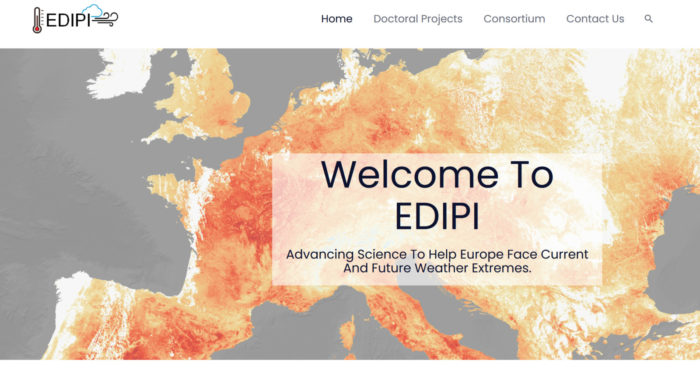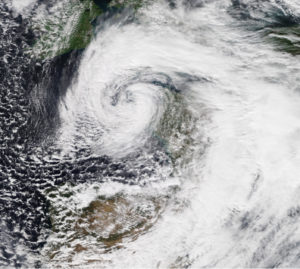
Extreme weather events routinely have detrimental socio-economic impacts around the globe. In fact, weather-related events make up over 90% of natural disasters worldwide [1]. In the new millennium, the frequency of many extreme weather events such as droughts and high temperatures, has systematically exceeded the levels seen in the 1980s and 1990s [1], and anthropogenic climate change may further aggravate such trend [2]. This has led to a growing scientific and societal awareness of the importance of understanding extreme weather events, which has been mirrored in recent European and global policies. The European Commission recognises climate change, including changes in the frequency and characteristics of extreme events, as a transnational problem, and the United Nation’s World Climate Research Programme has listed understanding current and future weather extremes as a grand challenge of climate science.
From a scientific perspective, studying extreme weather events is a multifaceted endeavour. First of all, extremes are by definition rare, meaning that our understanding of extremes relies on a relatively small number of observations. There is no easy solution to this, as no matter how much data we have, extremes will always only make up a small part of it… otherwise they would not be extremes to start with! This in turn makes it difficult to predict how the occurrence and characteristics of extremes may change in the future. From a practical point of view, the impacts of extreme weather events are multifarious and may only be understood in a multidisciplinary perspective. For example, a heatwave may have major impacts on public health (e.g. death of people already in precarious health conditions), on vegetation (e.g. browning or die-back), on livestock (e.g. lowered milk production, lower birth rates, etc.), on energy production (e.g. difficulties in cooling power plants) and on industrial output (e.g. factory closures due to excessive temperatures). No single discipline can incorporate all of these aspects. A better understanding of extreme weather and its impacts can therefore only be achieved through a multidisciplinary, collaborative effort.
The European research community has risen to such challenge thanks to centralised European Union research funding agencies under the European Commission, such as the Research Executive Agency and the European Research Council. The support from these funding agencies provides us with opportunities to organise large international consortia and see high-risk, high-gain projects come to fruition. One such consortium, recently received funding to conduct research on extreme weather events in Europe. The european weather Extremes: DrIvers, Predictability and Impacts (EDIPI) consortium is comprised of nine universities/research centres and 11 partner organisations, ranging from insurance companies to operational forecasting centres. EDIPI is funded under the Marie Skłodowska-Curie programme and will hire 14 Ph.D. students across several countries, starting from 2021. The project aims to both advance our scientific understanding of extreme weather and train a cohort of young researchers, who may ensure continued efforts in this field in the upcoming years.

Figure 1: Storm Alex, here pictured on October 2nd, which inaugurated the 2020–21 European windstorm season. Image Credits: Nasa Worldwide.
The project mainly addresses temperature, precipitation and surface wind extremes over Europe and the Mediterranean, and will tackle three overarching scientific questions: 1) Why does a specific type of weather extreme occur? 2) How can we use this knowledge to better predict when it will occur? And, 3) what are the likely impacts once it does occur? To answer these critical questions, EDIPI will combine climate science, statistical mechanics, dynamical systems theory, risk management, agricultural science, epidemiology and more. One of the Ph.D. projects seeks to leverage concepts from statistical mechanics to simulate a large number of winter storms (such as the one shown in Fig. 1) in a computationally efficient way with a numerical climate model. Another project will use data from social networks to forecast temperature-attributable mortality. A third project will use numerical models from the insurance sector to better quantify future losses from European windstorms. On the training front, EDIPI will ensure an active exchange between the academic, public and private sectors. A key aim of the project is to prepare the Ph.D. students to a broad range of career options in the field of weather extremes, both within and beyond academia.
EDIPI will be advertising doctoral positions in the early 2021. More information on the individual Ph.D. projects, participating institutions and supervisors can be found at edipi-itn.eu.
This post is a co-blog by the EGU divisions of Atmospheric Science, Climate: Past, Present & Future, and Nonlinear Processes in Geosciences and has been edited by the editorial boards.
References: [1] D. Guha-Sapir (2020). Human Cost of Disasters 2000-2019 - Key Insights. Accessed 20/10/2020 at: https://cred.be/sites/default/files/WorldDisasterDayOct12presentationDebby-2.pdf [2] Rahmstorf S, Coumou D. 2011. Increase of extreme events in a warming world. Proc. Nat. Acad. Sci., 108(44), 17905-17909.

